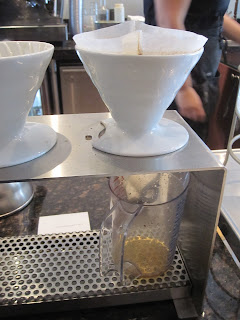
Adding cold water to the coffee.
I've been thinking about cold infusions lately. Infusions that don't require heat and are not destructive (changing) to the ingredients used. Heat up the ingredients and a change occurs. What ways can we move to infuse liquids while trying to capture the vibrancy of the natural ingredients?
A technique developed by Dave Arnold at the French Culinary Institute described using an iSi Whip Charger to infuse flavors. At its most basic, the iSi is widely used to make whipped cream. Insert cream, add a little sugar, seal and charge with a nitrogen cartridge and you've got ready made whipped cream.

Double-charged and three minutes.
The whipper is a great tool and I've used it before to make foams and played a little with them to inject carbon dioxide into products - "Strawberry Soda", anyone?
All of this started the other night while I was lying in bed thinking about mole - that ubiquitous Mexican dish of spices, chiles, nuts and cocoa. How might we be able to create a drink that represented mole?

Straining the liquid infusion.
Originally, I pondered this similar question four years ago and didn't get very far. The complex and powerful flavors of the mole, not to mention the gritty paste (for a drink) that serves as the base, made it difficult to work with and I soon abandoned that idea for others (the "Breakfast In Bed" concept).
Fast forward four years and I'm back in the same situation, considering the options. This time, the potential lies in being able to take the ingredients and infuse them into a liquid to carry the flavor and combine that with coffee (or espresso). And maybe Dave's idea of cold infusion might work.

Still a bit cloudy.
But without the necessary ingredients at the ready to make a proper mole, I decided to give it a conceptual try using whatever we had on hand - namely coffee. Stumptown's Finca San Vicente coffee from Honduras has been performing brilliantly this week with notes of vanilla, cinnamon, caramel, hops and macadamia nuts and would make for an interesting test subject. What kind of notes and nuances might we be able to extract from the coffee with this method?
As a baseline, we took 24 grams of the San Vicente and ground it coarser than for french press on a Compak R80 grinder (roughly the 90 setting). Placed that in the iSi Whipper along with 14 ounces of cold water. Screw the top on tight and charge with two (2) nitrogen cartridges, making sure to wait a few moments to allow the nitrogen to absorb into the liquid and shake well between charges.

Through a paper filter.
Once charged, we waited about three (3) minutes for the infusion to take place, being sure to note the fact that if we had simply brewed the coffee it would have taken the same amount of time.
Degas the whipper by holding it upright and using a container to catch any liquid that may come through the nozzle. Slowly allow the gas to escape and then unscrew the top. You'll notice that the liquid looks like it's boiling. This is perfectly normal. After straining the liquid, we noticed that there were still quite a bit of particulates in the liquid and then passed it through a paper coffee filter. Note: it will be more efficient to stir the liquid in the whipper and then pour the entire contents through the paper filter instead of using the strainer first. Passing strained coffee liquid through a paper filter always results in too many fines clogging the filter and slowing the process immensely.

Gassed up.
We tasted the liquid and it was light, fruity with a slight tartiness. Jacked it up with a little simple syrup and the liquid became vibrant. What were just a moment ago light and elusive fruit flavors were now dominate notes of tamarind - both sweet and tarty.
But it needed something more to give it a kick. Back into the iSi, we hit it with one charge of carbon dioxide, degassed and then poured it out.
Something to keep in mind about carbonation: you want the liquid to be cold. CO2 does not hold in warm temperatures. It simply gasses out into the environment. Which is why warm Coke goes flat at alarming rates. The colder the better. We added ice cubes to the iSi to chill down the liquid and keep it as cold as possible.

Finished. Sort of.
Degas the whipper in the same manner as before and we found a lovely amber colored liquid with lovely notes of tamarind and that refreshing carbon dioxide kick. It really brought it to life.
Next week: time to give it a try with actual mole ingredients!